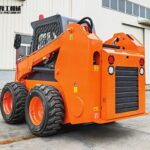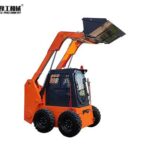Small track skid steer is a compact piece of machinery equipped with tracks instead of wheels. Unlike wheeled skid steers, track skid steers provide enhanced stability and traction, especially on uneven or soft ground. Despite its small size, this machine is capable of lifting, pushing, digging, grading, and transporting materials efficiently. Its compact size, powerful engine, and ability to work in tight spaces make it an essential tool across industries such as construction, agriculture, landscaping, and material handling.
Small Skid Steer Features
- Compact Size, Big Capabilities
Small track skid steers are engineered to maximize utility in minimal space. They can slip through standard doorways, navigate narrow pathways, and operate in backyard gardens without damaging turf. - Rubber Tracks for All-Terrain Performance
The defining feature of these machines is their rubber tracks, which distribute weight more evenly than tires. This reduces ground pressure, minimizing soil compaction and lawn damage. - High-Flow Hydraulics for Versatility
Modern mini track skid steers are equipped with advanced hydraulic systems. This enables seamless operation of high-demand attachments like hydraulic breakers, cold planers, and trenchers.
Small Track Skid Steer Structural Components
- Main Frame and Chassis
The chassis serves as the backbone, supporting the engine, cab, and lift arms. Reinforced with high-strength steel, it withstands the stresses of heavy lifting and rough terrain. - Undercarriage System
The undercarriage, which includes tracks, rollers, and sprockets, requires regular maintenance to ensure its longevity. Key components:
Tracks: Made of durable rubber with embedded steel cords for strength.
Idlers and rollers guide and distribute the weight evenly.
Sprockets: Engage with track links to propel the machine forward. - Hydraulic System
Hydraulics power the lift arms and attachments. A pump generates pressure, which flows through hoses to actuator cylinders or motors. Modern systems use electronic controls to optimize flow and reduce energy waste.
Advantages of Small Track Skid Steer
- Enhanced Traction
Tracks provide superior grip on muddy, sandy, or snowy surfaces compared to wheeled machines. - Low Ground Pressure
The weight distribution minimizes soil compaction, which is crucial for landscaping and farming. - Versatility
With dozens of compatible attachments, one machine can perform the tasks of multiple types of equipment. - Compact Mobility
Its small footprint allows it to work in confined areas where larger machinery cannot operate.
Applications Across Industries
- Construction and Site Preparation
From excavating foundations to grading driveways, small track skid steers handle diverse tasks with ease. Their ability to switch attachments—such as buckets, augers, and rakes—makes them invaluable for:
Land clearing: Removing trees, stumps, and overgrowth.
Utility work: Installing pipes, cables, and irrigation systems.
Demolition: Breaking concrete and removing debris in confined spaces. - Landscaping and Grounds Maintenance
Landscapers rely on small skid steers for their precision and low ground impact. Common uses include:
Turf management: Aerating, dethatching, and spreading topsoil.
Hardscaping: Moving pavers, gravel, and retaining wall blocks.
Snow removal: Equipped with blowers or pushers for efficient clearance. - Municipal and Public Works
Municipalities use small track skid steers for:
Park maintenance: Cleaning trails, removing invasive species, and installing signage.
Disaster response: Clearing debris after storms or floods.
Winter services: Keeping sidewalks and parking lots accessible during snowstorms.



